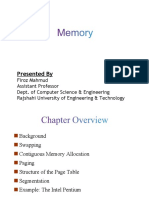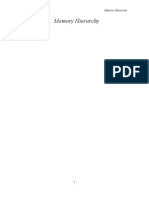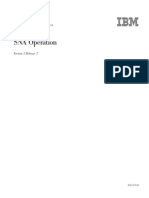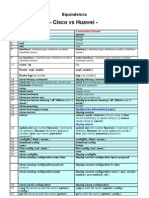Computer Architecture
Uploaded by
quoc leComputer Architecture
Uploaded by
quoc leHo Chi Minh City University of Technology COMPUTER ARCHITECTURE
Faculty of Computer Science and Engineering Practical session - Semester 211
WEEK 4
Memory:
Cache and Virtual memory
1 Introduction
1.1 Aims
• Understand principle of mapping in cache.
• Practice determining memory accessing time and performance.
1.2 Documents and lab materials
The same as week 1.
1.3 Report requirements
• For questions (if any), write your answers in a report (.pdf format), remember to include your name
and student ID. Name the report file with format <student ID>-<lab number> (ex: 2012345-
lab1.zip) (ex: 2012345-lab4.pdf) and submit to BK-elearning by the deadline.
2 Quiz
Answer below questions with detailed explanation.
2.1 Question 1
Given the main memory that has an address space of 32 bit, a cache with the size of 1 MB, 1 block is
256B, the accessing unit of the system is 1 byte. Determine the bit-width of tag, index, byte-offset with
below configurations:
a. Directed map.
b. 4-way set associative.
c. Full associative.
Computer Architecture - Semester 211 1/3
Faculty of Computer Science and Engineering Department of Computer Engineering
2.2 Question 2
Given the main memory that has the capacity of 256MB, a cache with the size of 256KB, 1 block is
64 words, the accessing unit of the system is 2 bytes. Determine the bit-width of tag, index, byte-offset
with below configurations:
a. Directed map.
b. 4-way set associative.
c. Full associative.
2.3 Question 3
A program accesses data in main memory with the sequence below (word address): 0,
4, 1, 5, 65, 46, 1, 70, 2, 0
Know that the system is 256B cache, 4-word block, 1-byte accessing unit. Hit time = 6 cycles, RAM
(main memory) access time = 10ns, the system works with the frequency of 2GHz.
Determine the number of HIT/MISS when executing the program, then calculate the AMAT (Average
memory access time) with the below configurations:
a. Directed map.
b. 2-way set associative.
c. Full associative.
2.4 Question 4
Given L1 cache hit time is 10 cycles, L2 cache hit time is 15 cycles, time to access RAM (main
memory) is 100 cycles. L1 miss rate is 25%, L2 miss rate is 5%. Determine AMAT of the system.
2.5 Question 5
Determine average CPI of a pipeline system that its Instruction memory miss rate is 5% and its Data
memory miss rate is 10%. Know that the program has 1000 instructions included 100 load/store
instructions and miss penalty is 100 cycles.
Computer Architecture - Semester 211 2/3
2.6 Question 6*
Virtual memory uses a page table to track the mapping of virtual addresses to physical addresses. The
following data constitutes a stream of virtual addresses as seen on a system. Assume 4 KB pages, a 4-entry
fully associative TLB, and true LRU (Least Recently Used) replacement. If pages must be brought in from
disk, increment the next largest page number.
Valid Tag Physical Page Number Valid Physical Page/Disk
1 11 12 1 5
1 7 4 0 Disk
1 3 6 0 Disk
Table
0 4 1: TLB 9 1 6
1 9
Stream of virtual addresses: 1 11
4669, 2227, 13916, 34587, 48870, 12608, 49225 0 Disk
1 4
0 Disk
0 Disk
Table 2: Page table
1 3
a. Given the address stream shown, and the initial TLB and 1 page table states 12 provided above.
Determine the final state of the system. Also list for each reference if it is a hit in the TLB, a hit in the
page table, or a page fault.
b. Repeat task a., but this time use 16 KB pages instead of 4 KB pages. What would be some of the
advantages of having a larger page size? What are some of the disadvantages?
c. Show the fi nal contents of the TLB if it is 2-way set associative, direct mapped.
You might also like
- Physical Storage Systems: Practice ExercisesNo ratings yetPhysical Storage Systems: Practice Exercises2 pages
- Discuss How The Following Pairs of Scheduling Criteria Conflict in Certain SettingsNo ratings yetDiscuss How The Following Pairs of Scheduling Criteria Conflict in Certain Settings13 pages
- GH-Tekla Link Version 1.5 Release NotesNo ratings yetGH-Tekla Link Version 1.5 Release Notes15 pages
- P1 Gen 2, X1 Extreme and X1 Extreme 2nd Hardware Maintenance ManualNo ratings yetP1 Gen 2, X1 Extreme and X1 Extreme 2nd Hardware Maintenance Manual115 pages
- CSE 378 - Machine Organization & Assembly Language - Winter 2009 HW #4No ratings yetCSE 378 - Machine Organization & Assembly Language - Winter 2009 HW #411 pages
- mm CALCULATE CAPACITY OF A DISK SOLUTIONSNo ratings yetmm CALCULATE CAPACITY OF A DISK SOLUTIONS7 pages
- Computer Architecture Homework 5 - Due Date:08/11/2014: Class 11ECE NameNo ratings yetComputer Architecture Homework 5 - Due Date:08/11/2014: Class 11ECE Name4 pages
- This Assignment Can Be Done in Groups of 1, 2, or 3. The Assignment Is Worth 60 PointsNo ratings yetThis Assignment Can Be Done in Groups of 1, 2, or 3. The Assignment Is Worth 60 Points6 pages
- COD Homework 5 - Due Date:Final Exam: Class 11DT NameNo ratings yetCOD Homework 5 - Due Date:Final Exam: Class 11DT Name4 pages
- Microprocessors (22415) Diploma Micro Project I Scheme MSBTE. - MSBTE MICRO PROJECTS projectNo ratings yetMicroprocessors (22415) Diploma Micro Project I Scheme MSBTE. - MSBTE MICRO PROJECTS project7 pages
- Solid State Drive Technology For ProLiant ServersNo ratings yetSolid State Drive Technology For ProLiant Servers10 pages
- The Motivation For Caches: Memory SystemNo ratings yetThe Motivation For Caches: Memory System9 pages
- CS 61C: Great Ideas in Computer Architecture: Lecture 12 - Memory Hierarchy/Direct-Mapped CachesNo ratings yetCS 61C: Great Ideas in Computer Architecture: Lecture 12 - Memory Hierarchy/Direct-Mapped Caches27 pages
- 19CS2106S Lecture Notes Buffer Cache Algorithms & Logging Session - 5No ratings yet19CS2106S Lecture Notes Buffer Cache Algorithms & Logging Session - 55 pages
- Computer Science 146 Computer ArchitectureNo ratings yetComputer Science 146 Computer Architecture17 pages
- ECE4680 Computer Organization and Architecture Memory Hierarchy: Cache SystemNo ratings yetECE4680 Computer Organization and Architecture Memory Hierarchy: Cache System25 pages
- The Google File System: CSE 490h, Autumn 2008No ratings yetThe Google File System: CSE 490h, Autumn 200829 pages
- ACA Unit 6 - Part - Virtual Memory Notes - U6No ratings yetACA Unit 6 - Part - Virtual Memory Notes - U64 pages
- Computer Architecture: Optional Homework Set: Black Board Due Date: Hard Copy Due DateNo ratings yetComputer Architecture: Optional Homework Set: Black Board Due Date: Hard Copy Due Date8 pages
- SPRING 2015 CDA 3101 Homework 3: Date-Assigned: Mar 27th, 2015 Due Dates: 11:55pm, April 7th, 2015No ratings yetSPRING 2015 CDA 3101 Homework 3: Date-Assigned: Mar 27th, 2015 Due Dates: 11:55pm, April 7th, 20155 pages
- Nintendo 64 Architecture: Architecture of Consoles: A Practical Analysis, #8From EverandNintendo 64 Architecture: Architecture of Consoles: A Practical Analysis, #8No ratings yet
- PlayStation 2 Architecture: Architecture of Consoles: A Practical Analysis, #12From EverandPlayStation 2 Architecture: Architecture of Consoles: A Practical Analysis, #12No ratings yet
- Guru Nanak Dev University: Date-Sheet ForNo ratings yetGuru Nanak Dev University: Date-Sheet For1 page
- Service Interface User Guide, February 2022 DOCA0170EN-02No ratings yetService Interface User Guide, February 2022 DOCA0170EN-0264 pages
- Quantus Fluorometer Operating Manual TM396No ratings yetQuantus Fluorometer Operating Manual TM39617 pages
- Vinayak Soin 102115159 3NC7: Name of Student: Roll Number: GroupNo ratings yetVinayak Soin 102115159 3NC7: Name of Student: Roll Number: Group3 pages
- Middle Ear Analyzer: Diagnostic & Clinical Tympanometry With Basic AudiometryNo ratings yetMiddle Ear Analyzer: Diagnostic & Clinical Tympanometry With Basic Audiometry8 pages
- Miama: A Small Introduction To The Free Font Miama by Linus Romer, AugustNo ratings yetMiama: A Small Introduction To The Free Font Miama by Linus Romer, August5 pages
- Be Information Technology Semester 5 2023 December Software Engineeringrev 2019 C SchemeNo ratings yetBe Information Technology Semester 5 2023 December Software Engineeringrev 2019 C Scheme1 page
- Pega Study Tutorial Interview QuestionsNo ratings yetPega Study Tutorial Interview Questions318 pages
- A Report Submitted: Dit University, DehradunNo ratings yetA Report Submitted: Dit University, Dehradun28 pages
























































































